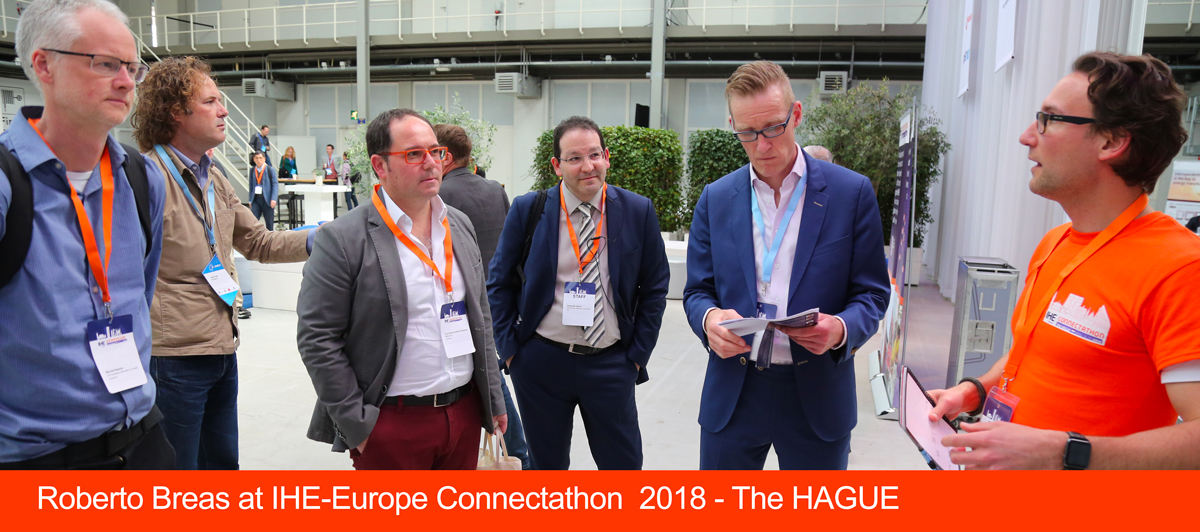Robert is an MSc graduate of the Erasmus University, Rotterdam and his 2007 Masters thesis “Workflow Management, the Challenges for Healthcare” were the first steps towards his career in healthcare.
Robert has been working on interoperability matters and been active within IHE-Netherlands for some 15 years. Initially he worked for Nictiz, a Dutch health IT company that manages international standards which enable information exchange (particularly in healthcare) where he was engaged with the European epSOS and Snomed CT® projects.
In 2012 he started supporting interoperability projects as a Senior Consultant and Tutor in eHealth Interoperability for MedicalPHIT. MedicalPHIT is a Dutch independent consultancy company for health IT. “It provides me the opportunity to influence and help implement better healthcare through the application of IT to enable both proficient and efficient data sharing and through training others in my speciality areas of healthcare networks, regional and cross-border data sharing, health IT interoperability standards application – IHE profiles- and eHealth standardisation developments”, he said.
IHE Experience
Robert became Technical Manager for IHE-Netherlands in 2010 and attended his first IHE-Europe Connectathon in 2011 in Pisa, Italy. He was immediately impressed by the whole set-up of IHE, the people – many experts in their own fields - involved in it, who freely gave their time and their knowledge to those present – vendors large and small – and the work ethic of working together to achieve interoperability of systems.
His experience as an IHE Monitor began in Istanbul at the 2013 IHE-Europe Connectathon: “This showed me how vendors work together and as an IHE Monitor I was able to facilitate many test instances. Monitoring and providing support during the ‘testing marathon’. I found it insightful and stimulating to be part of the process and the camaraderie between vendors meant the learning experience was great for all”, he observed.
“I should pay tribute to many IHE experts who helped me during these early days, one in particular stands out - Dr Dave Harvey from UK had the ability to explain things in a down to earth way that encouraged learning, yet as a top radiologist he knew the clinical side of things and the benefits that the use of IHE interoperability Profiles brought to improved patient care and hence the importance of document and image sharing to that end, his sudden death was a shock to us all”, Breas added.
“Other colleagues including ‘Master of Monitors’ - Eric Poiseau – was a big influence and we all learned from each other in a true IHE community spirit” he commented. “They all worked very hard during the IHE Connectathon wanting as many tests as possible to be positive and the networking with like-minded people was stimulating”.
Value of the IHE Connectathon to Vendors and to Monitors
Vendors clearly benefit from the Connectathon environment and the chance to work together through problems, without fear of competition or failure is important. Robert strongly supports the face-to face testing: “Not only do vendors feel more relaxed and the unplanned parts of networking with peers and experts is a real bonus but as IHE Monitors we are able to work better and we learn and improve our knowledge base too from the experiences.”
Testing tools have progressed a lot over the last few years and have helped with a more structured approach so more tests can be done and more successful tests completed.
“I am a great fan of learning and the VIP Tours of the IHE-Europe Connectathon Floor offer a valuable opportunity for all attendees, of whatever level of knowledge and experience, to actually understand what IHE is and how it works in practice. They can tangibly see interoperability testing first hand and talk to vendors about what they are doing as opposed to just an abstract set of documents. In return the vendors are able to interface with the tour delegates and gain feedback; this is largely impossible or impracticable even in a virtual Connectathon”, Breas commented.
“It is hugely important for vendors to participate in IHE Connectathons, existing vendors need to test their latest products, their latest software versions and their solutions against and alongside new and emerging vendors. New vendors need to be fully aware of the standards and how they are applied in real world situations. There are still companies who go into deployments blind and invariable find serious problems of interoperability, all that can be easily ironed out at a Connectathon”, he added.
There are still instances where vendors do not appreciate that open standards application is important but a no standards application can easily be set up to fail in implementation and prove expensive to fix for the vendor, to say nothing of the consequential deployment delays and inconvenience.
Message to Future Monitors
Robert’s message is clear: “Participating in a Connectathon is a fantastic way to learn and enhance your skills, it is not a pressured environment and sharing knowledge comes naturally to the Monitors so I would encourage anyone thinking of becoming an IHE Monitor to give it a go and as long as you are prepared to learn then you will make a success of it. Initially new IHE Monitors may double up to learn the ropes, but we all started somewhere and you will find that with like-minded individuals who are enthusiastic and keen to learn more about interoperability there is no shortage of peers keen to help you. You also have your areas of expertise that others can learn from you and the networking both in the IHE-Europe Connectathon itself and in the social times that inevitably means both environments are a fertile ground for learning. It is also a fun experience being a Monitor and there is great interaction amongst the Monitor team and sense of everyone contributing. I recommend everyone with an independent unaligned view on interoperability to offer their services as an IHE Monitor”, Breas concluded.




